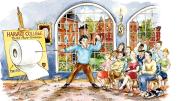1913
The Alumni Bulletin welcomes the founding of the Harvard University Press as an “eminently appropriate [way to] powerfully advance the general cause of learning.”
1923
President Lowell’s refusal to let the son of a black alumnus live, as other freshmen must, in the freshman dormitories creates a furor in the Bulletin’s letters section and in the public press.
1938
After 40 and 13 years, respectively, on the research staff of the Harvard Observatory, astronomers Annie Jump Cannon and Cecilia Payne-Gaposchkin receive Corporation appointments.
1943
The presidents of Harvard, Yale, and Princeton issue a joint statement agreeing to forgo “athletics as usual” for the duration.
1953
Students voice disgust when the faculty approves new rules that allow women to stay in undergraduate rooms until 11 p.m. instead of 8 p.m. on Saturday nights, but completely eliminate the visiting hours of 1 p.m. to 4 p.m. for the rest of the week.
1958
The Harvard Corporation issues the go-ahead on the construction of Harvard’s eighth undergraduate House, Quincy.
1968
A letter calling for de-escalation of the war in Vietnam, with 4,000 signatories representing 54 percent of the faculty and 51 percent of Harvard and Radcliffe undergraduates, has been presented to President Lyndon Johnson. University Professor Edwin O. Reischauer, former ambassador to Japan, and one of the project organizers, calls it “a remarkable fact that 54 percent of the Harvard faculty signed anything.”
1998
In response to student demands, the College replaces one-ply toilet paper in undergraduate residences with the more luxurious two-ply variety. Dean Harry R. Lewis explains that a “high-level committee, called the Harvard College Toilet Paper Commission, consisting of the Administrative Board, the Faculty Council, the Committee on House Life, the Committee on College Life, and the Masters of the Houses…met weekly all fall to consider this important issue.”








